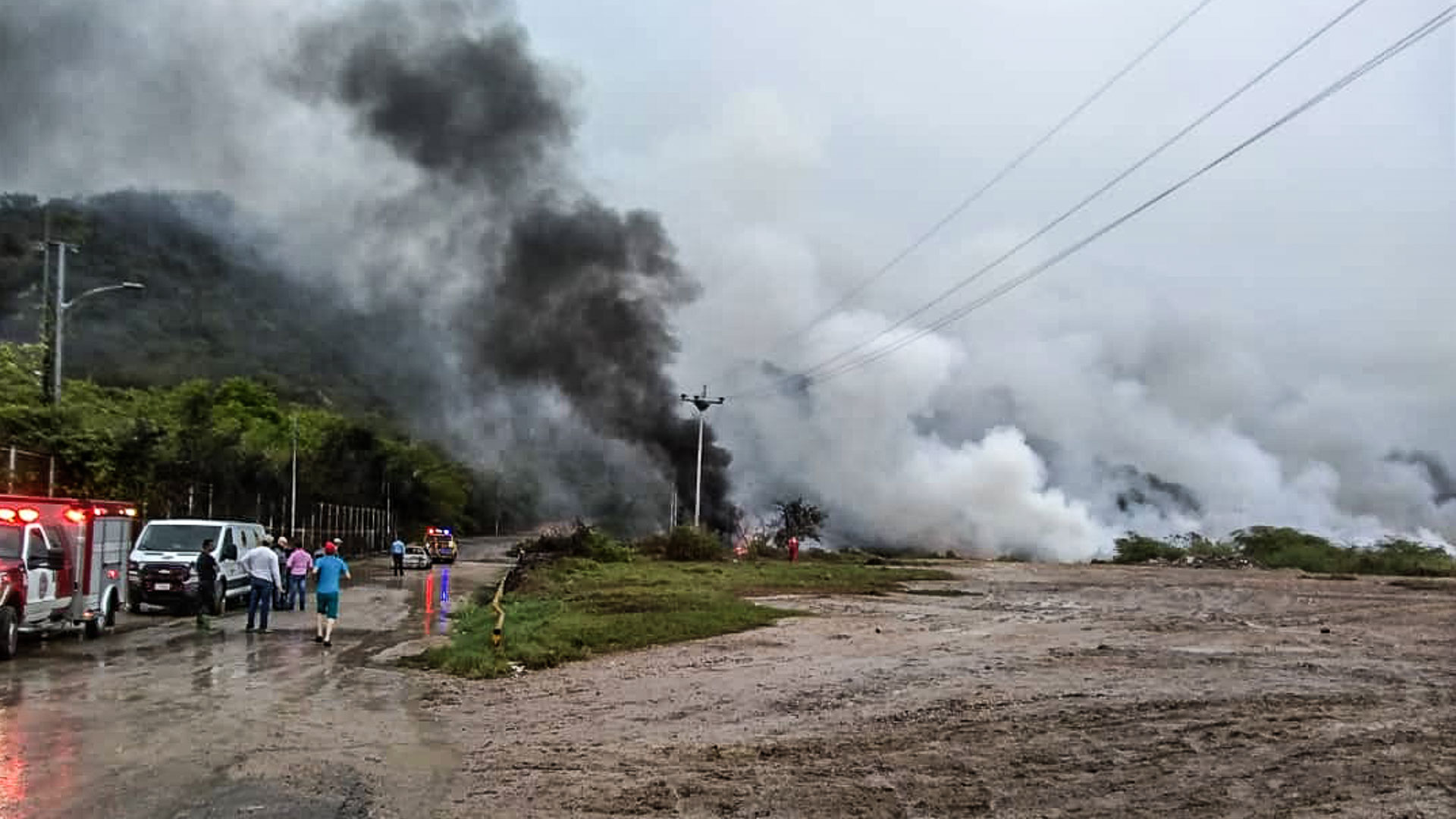

The inhabitants of Guanta, a city in the state of Anzoátegui bordering Puerto La Cruz, Barcelona and Lechería, live in fear. A refinery has been operating there for 69 years now and they are well aware that an accident could put them at risk. And that is exactly what happened on the Saturday evening of June 8 of 2019: heavy rainfall was followed by three explosions that rocked the area and killed three people. Journalist Magda Llovera, a Guanta neighbor, shares her first-hand experience during those agonizing hours.

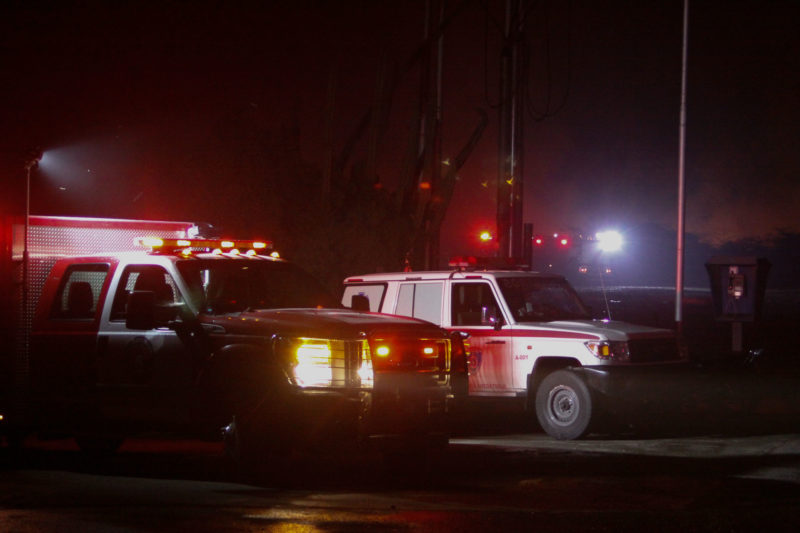 Photos: Arturo Ramírez / Cover: Magda Llovera
Photos: Arturo Ramírez / Cover: Magda Llovera
The threat of an explosion has always been there, latently. Ever since I arrived in Puerto La Cruz in 1981, I have consistently heard people say that this city is like a powder keg. And they say it because of the refinery, which was established 69 years ago. And they say it because of the oil. But never, until the afternoon of Saturday, June 8, 2019, did I think things would happen so close to where I was.
I had spent the entire day in Lechería, one of the municipalities of a four-city axis: Barcelona, Lechería, Puerto La Cruz and Guanta, which, being so close to each other, appear to be one. It had rained heavily after midday. A trough warning had been issued from a tropical wave. Concerned drivers wondered if they were going to be able to circumvent the large puddles of water that usually form on the road when it rains. But what was being spread on social networks were not photos of a flood: it was photos of a strong burst of flame and of thick black smoke. The only thing we knew for certain was that there was a fire in full progress in Guanta.
That is where I live, less than a mile from the refinery complex. Just 800 meters from where three people would burn to death on that rainy afternoon.
As soon as the fire started, so did the guesswork: that the fire had started in an old fish market, or that it had been in the facilities of a cargo carrier. That people had died; some said it was one, some other that it was three. Gradually, things were getting clearer and, since I am journalist, I hurried to the site to find out what had really happened.
A car had caught fire on the El Chaure-Punta Meta-Juan Pedro road (a residential development, a fishing port next to a military facility, and a Great Mission Housing complex, in that order). Three members of a family —father, mother, daughter— had died, and another person had sustained burns to 90 percent of his body. Jesús Javier Marcano, the sole survivor, was initially transferred to the Luis Razetti hospital in Barcelona, and from there to a private clinic, and finally to the Maracaibo’s Burn Care Center.
The fire had engulfed the Toyota Corola vehicle where they were travelling. Juan Carlos Salazar, Eulimar Rodríguez and their 4-year-old baby girl were killed. The car, which burned down to scrap, laid there in the middle of a pool of rainwater.
It would be later revealed that there was more in it than just water.
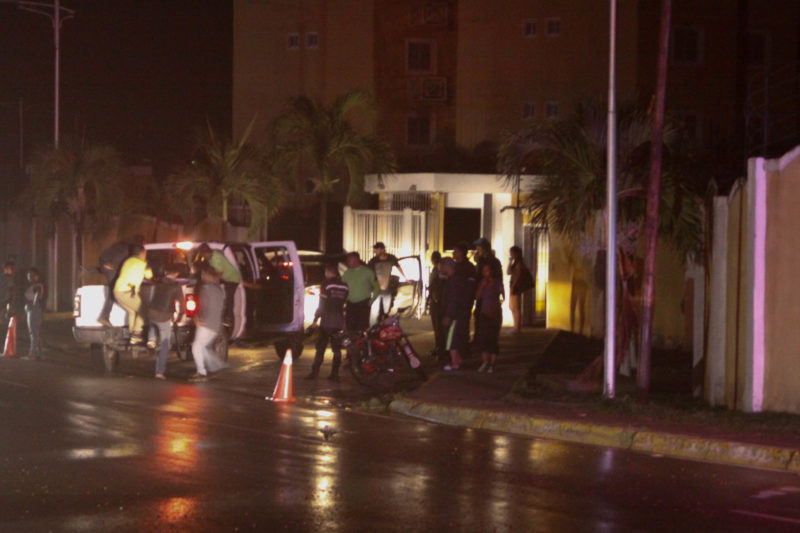
There was speculation about the causes of the tragedy: that the power line had been struck by lightning; that a high-voltage cable had come loose; that the Toyota had gone out while trying to cross a large pond of water and when the driver tried to ignite it, twice, a spark had ignited the fire. The fact is that the survivor managed to tell Civil Protection officials that the car went up in flames after an explosion was heard.
People then commented that ballast or hydrocarbon residue from the refinery, which had been dragged down by the rain into a ravine, had been found at the scene. The information was confirmed by Iván Gregorio Parra Vásquez, deputy commissioner of the Bolivarian National Police, when he declared about the accident. Sure, the official bulletin of the Eastern Strategic Region of Integral Defense reported otherwise: that a short circuit had caused the tragedy. Neither that day, nor the next day, did PDVSA [the oil-state company] issue a release.
The flames would not extinguish with the foam and water of the fire emergency trucks and crews of Anzoátegui, Marinos and PDVSA. People from the buildings of the nearest residential areas were baffled and distressed. Some of my neighbors were of the opinion that we needed to leave the buildings, while others did not seem to agree. Night had already fallen and there was no electricity. I would find out later that people from two of the buildings in my complex had decided to leave after the fire where the Salazar family was killed.
I went up to my apartment to remove the mud from my shoes and the pants that had gotten soiled after I made the tour of the area to inquire about the accident. I thought of going back to Lechería to take refuge in a relative’s house. The smell of smoke still lingered in the air: sometimes it was of burnt rubber, sometimes of bush. I was worried because the cell phone battery was about to die and I had no way to recharge it.
Then I felt a strong explosion.
As I looked out the window, I saw a yellow-orange-red column, wrapped in a black cloak, rise into the sky. It was 7:00 at night.
I was paralyzed. My mind went blank. And then I reacted. I thought there would be no one left in the building.
We would later learn that what we had feared for years had occurred: living in Guanta, we had been the witnesses —or the victims— of a blast, rather two in this, in a matter of seconds. Because it was two explosions, triggered by the buildup of fumes and gases from a source about which no explanation had been offered. Two explosions that seemed like one, in addition to the first one where Juan Carlos Salazar, his wife and his little daughter had died, very close from there.
That fireball that I saw broke inside the oil facility itself. Some said that behind the gas station on the road to Puerto La Cruz, where I usually fill my car’s tank; other argued that on the back of the Guanta cemetery.
From the parking lot, Daniela, a neighbor who lives on the third floor, shouted out to her husband Carlos:
“Ruuuuun! Ruuuuun! Let’s gooooo! Hurry uuuup!”
Another neighbor was running down from the fourth floor. I was in the second floor, in sort of a calmed distress state, and I yelled:
“Laaaaaly, Laaaaaly, what shall we do?”
“Come down to the parking lot!”
“Where are we going?”
“Come down!!! To Cumanááááá.”
From Guanta to Cumaná it’s a little more than an hour drive on a winding, dizzying road.
Armed with a flashlight, which barely lit, and a dying cell phone, I went down to the parking lot, where already a dozen neighbors had gathered, all from Building J, the one where I live. It was so dark that I couldn’t tell if more people had come out of the other buildings.
Our discussion was whether to run away from there or to stay. One neighbor stated that the mayor’s office had issued instructions to evacuate the place, that we needed to leave for Puerto La Cruz, but someone said that there was no way to get there because the road had been blocked.
“Then what?” I asked.
Laly replied that we were safer in Guanta, because all the oil pipes are in Puerto La Cruz. I guess she was referring to the great pipeline that runs across Puerto La Cruz to carry oil from the southern area of Anzoátegui.
I pictured the refinery in my mind, which was located on both sides of the interstate road. Gray tanks could be seen from each side. The refinery complex starts in Puerto La Cruz; entire slums and residential areas have been built around it, including educational institutions and healthcare centers. Its facilities extend as far as Guanta. It is no less than 800 hectares with 129 storage tanks, and the fourth most important refining complex in the country, after those of Paraguaná, in the state of Falcón (with the Amuay and Cardón refineries), El Palito in Carabobo and Bajo Grande in Zulia.
And I thought to myself: day after day we look at that row of tanks and other structures, never realizing the risk that it involves for us who live so close by. I remembered the last fires that ignited in the Puerto La Cruz area of the complex.
The first one occurred on August 11, 2013 and the second one on October 30, 2016, both on Sundays of heavy rain, in puddles of ballast water and caused by lightning. The residents of the nearby areas were terrified. The 2013 fire started close to the fuel filling area, and some 180 families who lived near the facilities had to be evacuated while efforts were made to suffocate the fire, as stated by the PDVSA authorities at the time. The second one, which happened three years ago, started in the Guaraguao loading hill, adjacent to the Guaraguao residential area and to the César Rodríguez hospital, the most important one in Puerto La Cruz. It caused such fear that patients had to be transferred to another healthcare center, with the frailest ones being transported on stretchers and others in wheelchairs or walking or on relatives’ cars.
This Saturday, June 8, the second explosion of the day, and the third one, which came immediately afterwards, were felt about five miles from the site, in the El Pensil slum of Puerto La Cruz, near the refinery’s gasoline filling area and the Bolivarian National Guard Command. As in 2013, people were overcome by fear. My neighbor on the first floor, Lourdes, lived through it now. She was at her mother’s house and saw when a resident of El Pensil went to the military installation to ask what they were going to do.
There was no answer.
That’s how we were in Guanta.
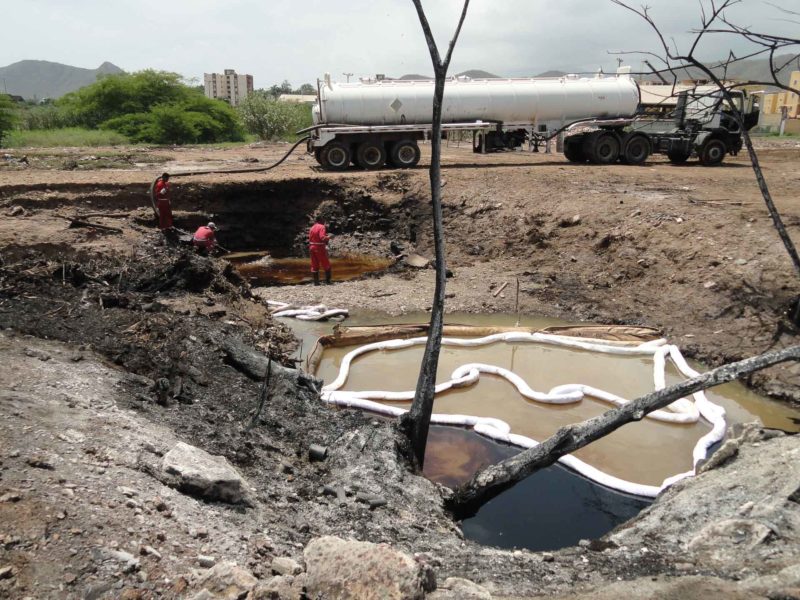
In the darkness of my building’s parking lot of, someone said the same thing as Laly had shouted at me:
“Our other option is to leave for Cumaná.”
It wasn’t an easy decision to make. To go to Cumaná at that time of the night was to risk getting robbed on the road, one that is famous because people are constantly mugged there. Even trucks carrying food are often the target of robbery.
“Come to Lechería,” my daughter wrote me via text message. I had borrowed a portable phone-battery charger from my neighbor Manuel and had managed to juice it up a little.
“How could I go there, if the road is blocked?” I replied.
I walked to the entrance of the residential complex. The gate was closed. I reckoned that if we had to evacuate the building, we would need someone to coordinate our exit. And what about those who didn’t have a car, I wondered. There are 192 apartment units in the building complex.
Nobody knew anything. I learned the next day that a pickup truck had been sent to nearby Parque Guaraguao, a residential area built on the security strip of the refinery, to transport a number of families similar to ours. And that the people from the Juan Pedro Endogenous Nucleus, which is the sector where the victims of the fire lived, had been evacuated by sea to Paseo Colón.
There was no contingency plan for us.
My daughter contacted a friend who lives in Guanta. She told her that the road to Puerto La Cruz was free. But I wrote her and repeated what Laly had said: “I’m safer in Guanta.” Her last message was a worried face emoji. People asked about me in the family chat. My daughter told them what she knew. “Obstinate”, an adjective to which I am not foreign, could be clearly read because of my refusal to leave the building. I moved away from the group of neighbors to send them a voice message. I insisted, “I feel safer here.” I wasn’t particularly fond of the tone I used. I realized it later, so I gave them a more detailed explanation in a gentler tone.
When I returned to where the neighbors were gathering, I heard Larisa, a woman from another tower, say to Laly:
“I’m leaving.”
“But what if our apartments are robbed?”
“I don’t care.”
We walked. It seemed like it would be a long night. We kept on swallowing smoke, sometimes black, sometimes gray in color.
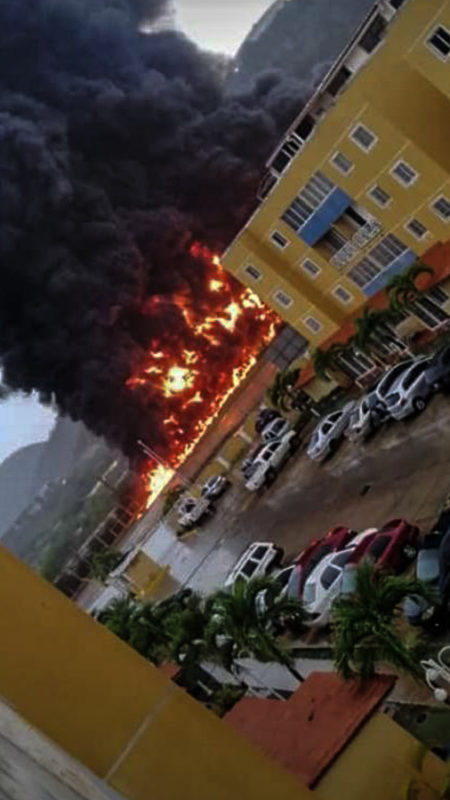
Larisa invited us to her house to charge our cell phones with a power plant that she had bought to cope with the blackouts that we began to experience in the area in the area since March 7. I asked her to wait for me because I needed to go home look for the charger. The smoke was still a heavy nuisance in my apartment. I walked down quickly.
And a few minutes later the power was restored.
“It’s all solved now,” said Laly, grateful. Deep inside of me, I thought so too. Blessed is the light. Not a word was uttered again about us leaving the residential complex.
We met in Laly’s apartment. Her husband, Jesús, who is a former PDVSA staff, showed us satellite images of the entire refinery complex and we talked about what had happened. Larisa recalled that the condominium association had reported time and again the oil spill at the site of the tragedy, but no one did anything to fix it.
I went home and I managed to fall sleep, although I was still restless.
The next day, from my window, I noticed a white thread of smoke. And that was when I realized that there is a large tank up on a hill, and some others at the bottom, near the site of the fire. We get so used to see them every day that they become invisible to us, just like our concern.
On Sunday, crews were sent to the site to collect the hydrocarbon in the water and do some earthmoving. But the fear is there. And rightly so. In August 2012, an explosion at the Amuay refinery in Falcón killed 55 people from nearby areas. And some other smaller-scale disasters have occurred in Puerto La Cruz.
So, this was just another warning. We still live in danger.
Translation: Yazmine Livinalli

Note: This is a story of the Venezuelan website La vida de Nos. It is part of its project La vida de Nos Itinerante, which develops from storytelling workshops for journalists, human rights activists and photographers coming from 16 states of Venezuela.
1693 readings
I graduated from the Central University of Venezuela in 1981 and I have been practicing journalism for 40 years... and I haven’t regretted it for a second. I was a full-time reporter, mostly of politics, until 1999. I have been working in El Tiempo, Puerto La Cruz, for 36 years and I am now looking for a little time to learn to tell stories. At least that’s what I am trying to do.
Un Comentario sobre;